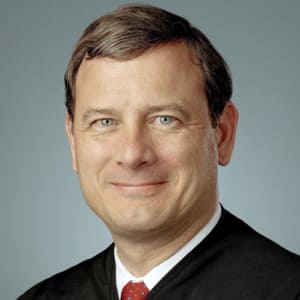
John Roberts
John Roberts became Chief Justice of the United States after he was nominated by George W. Bush in 2005.
Synopsis
U.S. Supreme Court Chief Justice John Glover Roberts Jr. was born on January 27, 1955 in Buffalo, New York. Roberts grew up in Long Beach, Indiana and attended Harvard Law School. He served on U.S Court of Appeals for two years before being confirmed as Chief Justice of the United States in 2005. In June 2015 Roberts ruled on two landmark legislative cases: He reaffirmed the legality of Obamacare, by siding with the liberal wing of the Court, along with swing vote Justice Anthony Kennedy. However, he held to his conservative views on the issue of gay marriage and voted against the Court's decision that made same sex marriage legal in all 50 states.
Early Life
John Glover Roberts Jr., the only son of John G. "Jack" Roberts Sr. and Rosemary Podrasky Roberts, was born in Buffalo, New York. In 1959, the family moved to Long Beach, Indiana where John grew up with his three sisters, Kathy, Peggy and Barbara. He attended Notre Dame Elementary School in Long Beach and then La Lumiere boarding school in La Porte, Indiana. John was an excellent student, very devoted to his studies, and he participated in several extracurricular activities including choir, drama, and student council. Though not an exceptionally gifted athlete, Roberts was named captain of the high school football team because of his leadership skills and excelled as a wrestler, becoming Regional Champion while at La Lumiere.
John Roberts entered Harvard College with aspirations of becoming a history professor. During the summers, he worked in a steel mill in Indiana to help pay his tuition. After graduating summa cum laude in three years, Roberts attended Harvard Law School, where he discovered his love for the law. He was managing editor of the Harvard Law Review and graduated magna cum laude with a J.D. (Doctor of Jurisprudence) in 1979. Due to his high honors at Harvard Law, he was recruited to clerk for Judge Henry Friendly of the U.S. Court of Appeals, Second Circuit. In 1980, he clerked for then-Associate Justice William Rehnquist on the U.S. Supreme Court. Legal analysts believe that working for both Friendly and Rehnquist influenced Roberts's conservative approach to the law, including his skepticism of federal power over the states and his support of broad executive branch powers in foreign and military affairs.
Attorney and Judge
In 1982, John Roberts served as aide to U.S Attorney General William French Smith and later as an aide to White House counsel Fred Fielding in the Reagan Administration. During these years, Roberts earned the reputation of being a political pragmatist, tackling some of the administration’s toughest issues (such as school busing) and matching wits with legal scholars and members of Congress. After working as an associate at the Washington D.C. law firm of Hogan & Hartson from 1987 to 1989, Roberts returned to the Justice Department under President George H.W. Bush as Principal Deputy Solicitor General from 1989 to 1993. In 1992, President Bush nominated Roberts to serve on the U.S. Court of Appeals for the D.C. District, but no Senate vote was held and his nomination expired when Bush left office.
During President Bill Clinton's administration, John Roberts returned to Hogan & Hartson as a partner where he became head of the appellate division arguing cases before the U.S. Supreme Court. During this time, Roberts argued in favor of a government regulation that banned abortion-related counseling by federally funded family-planning programs. In 1990, he wrote a brief that stated Roe v. Wade was wrongly decided and should be overturned and he co-authored a brief that argued in favor of clergy-led prayer at public school graduations. In November, 2000, Roberts traveled to Florida to advise then-Governor Jeb Bush on the recount of ballots during the 2000 presidential election between Al Gore and Bush's brother, George W. Bush.
Supreme Court
In January 2003, President George W. Bush nominated John Roberts for a position on the U.S. Court of Appeals. He was confirmed in May by voice vote with little opposition. During his two-year tenure on the Court, Roberts wrote 49 opinions of which only two were not unanimous and he dissented in three others. He ruled on several controversial cases including Hedgepeth v. Washington Metro Transit Authority upholding the arrest of a 12-year-old girl for violating the “no eating food” policy at a Washington D.C. Metro station. Roberts was also part of the unanimous ruling in Hamdan v. Rumsfeld upholding military tribunals’ trying terrorism suspects known as "enemy combatants." This decision was overturned in a 5-3 decision by the U.S. Supreme Court in 2006 (Chief Justice Roberts excused himself from this case).
On July 19, 2005, following the retirement of Associate Supreme Court Justice Sandra Day O'Connor, President George W. Bush nominated John Roberts to fill her vacancy. However, on September 3, 2005, Chief Justice William H. Rehnquist died following a long illness. On September 6, President Bush withdrew Roberts's nomination as O'Connor's successor and nominated him for the position of Chief Justice. During his confirmation hearings, Roberts dazzled both the Senate Judiciary Committee and a nationwide audience watching on CSPAN with his encyclopedic knowledge of Supreme Court precedent, which he discussed in detail without notes. While he gave no indication of how he would rule on any particular case, he did state that the issues he argued for while deputy solicitor general were the views of the administration he was representing at the time and not necessarily his own. Roberts was confirmed by the full Senate on September 29, 2005 as the 17th Chief Justice of the United States by a margin of 78-22, more than any other nominee for Chief Justice in American history. At age 50, Roberts became the youngest person confirmed as Chief Justice since John Marshall in 1801.
Before his confirmation, Roberts's brief stint on the U.S. Court of Appeals didn't provide an extensive case history to determine his judicial philosophy. Roberts has denied he has any comprehensive jurisprudential philosophy and believes no having one is the best way to faithfully construe the Constitution. Some Supreme Court observers believe Roberts puts this attitude into practice, noting that he is a master at building consensus for his judicial opinions by citing the opinions of his fellow justices. Others have observed this shrewd tactic has allowed Roberts to incrementally move the court's decisions to the right by tailoring his arguments and decisions in such a way so as to cultivate the support of more moderate justices.
Chief Justice of the United States
In his brief tenure on the Court, Chief Justice Roberts has ruled that in certain circumstances local governments can be exempt from some procedural requirements of the Voting Rights Act of 1965. He has ruled that the exclusionary rule needn't be so broad and that some evidence can be admissible even if obtained through police negligence. Roberts wrote the majority opinion against using race as a criterion in voluntary desegregation policies, a ruling which dissenting justices said stood Brown v. Board of Education on its head.
One of his more controversial decisions came in 2010 when Chief Justice Roberts concurred with Justice Kennedy in Citizens United v. Federal Election Commission, which declared that corporations have the same rights as average citizens engaging in political speech. Critics allege that the decision ignores the vast discrepancy between a corporation's finances and average citizen and destroys years of reform efforts to limit the power of special interest groups to influence the voters. Supporters hailed the decision as a boost for the First Amendment because campaign finance reform's efforts to force equality of free speech are contrary to protecting speech from government restraint. The ruling moved President Barack Obama to criticize the court's ruling during his 2010 State of the Union address and that, in turn, prompted Roberts to characterize Obama's choice of venue to criticize the court as "very troubling."
Roberts made headlines again in June 2012, when he voted to uphold a mandate in President Barack Obama's Patient Protection and Affordable Care Act (initiated in 2010), thus allowing other important pieces of the law to stay intact, including free health-screenings for certain citizens, restrictions to stringent insurance company policies, and permission for citizens under age 26 to be insured under parental plans. Roberts and four other justices voted to uphold the mandate, under which citizens are required to purchase health insurance or pay a tax—a main provision of Obama's health-care law—stating that while the mandate is unconstitutional, according to the Constitution's commerce clause, it falls within Congress' constitutional power to tax. Four justices voted against the mandate.
In June 2015 Roberts ruled on two landmark legislative cases. Siding with the liberal wing of the Court and its swing vote Justice Anthony Kennedy in a 6-3 decision, Roberts reaffirmed the legality of Obamacare by supporting the law's subsidy programs in King v. Burwell. However, Roberts upheld his conservative views on the issue of gay marriage and voted against the Court's decision that made same sex marriage legal in all 50 states.
Of the Court's 5-4 ruling to legalize gay marriage, Roberts was bold in his protest, claiming it undermines the country's democratic process. "If you are among the many Americans — of whatever sexual orientation — who favor expanding same-sex marriage, by all means celebrate today's decision," he wrote in his 29-page dissent, which was released on the day of the historical announcement on June 26, 2015. "Celebrate the achievement of a desired goal. Celebrate the opportunity for a new expression of commitment to a partner. Celebrate the availability of new benefits. But do not celebrate the Constitution. It had nothing to do with it."
Chief Justice John Roberts, undoubtedly, has a significantly powerful administrative position. When the Court majority is aligned with the Chief Justice, he chooses who will write the opinion, which can determine how broad or narrow the ruling will be and set a precedent, however small, toward a particular interpretation of the law.



